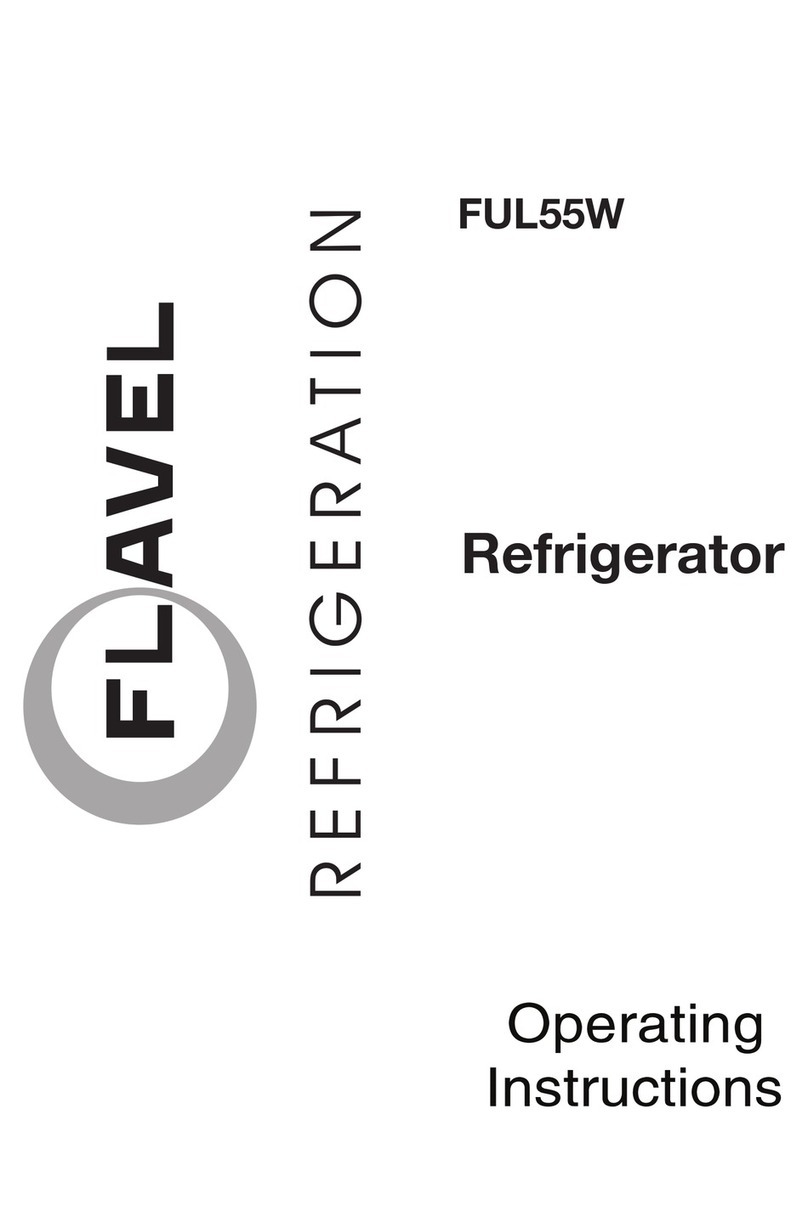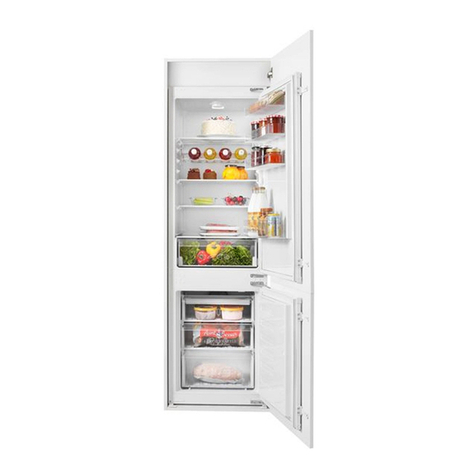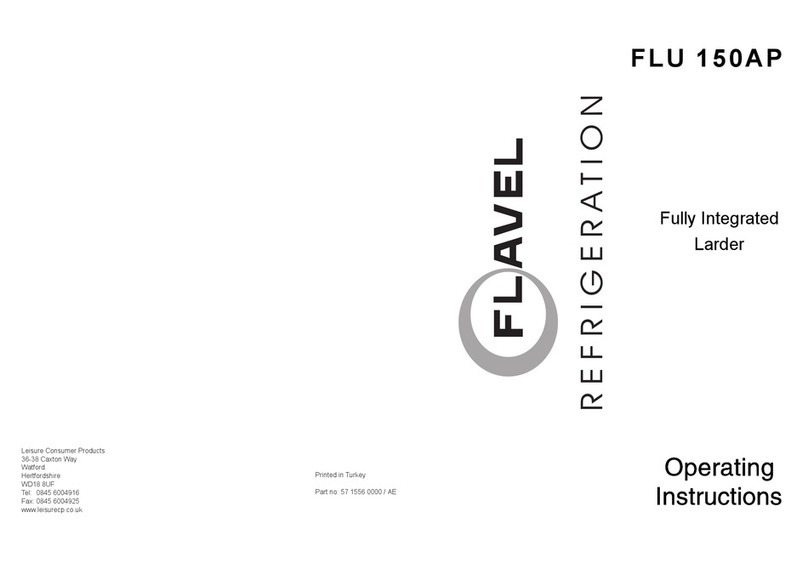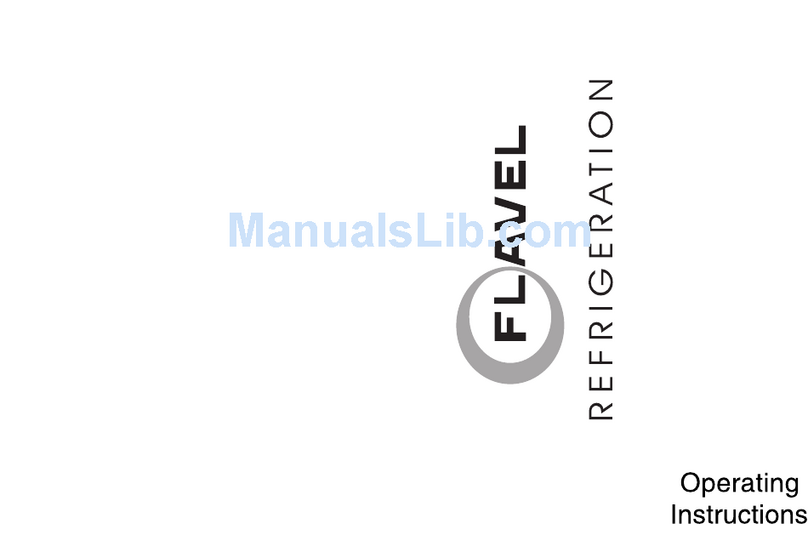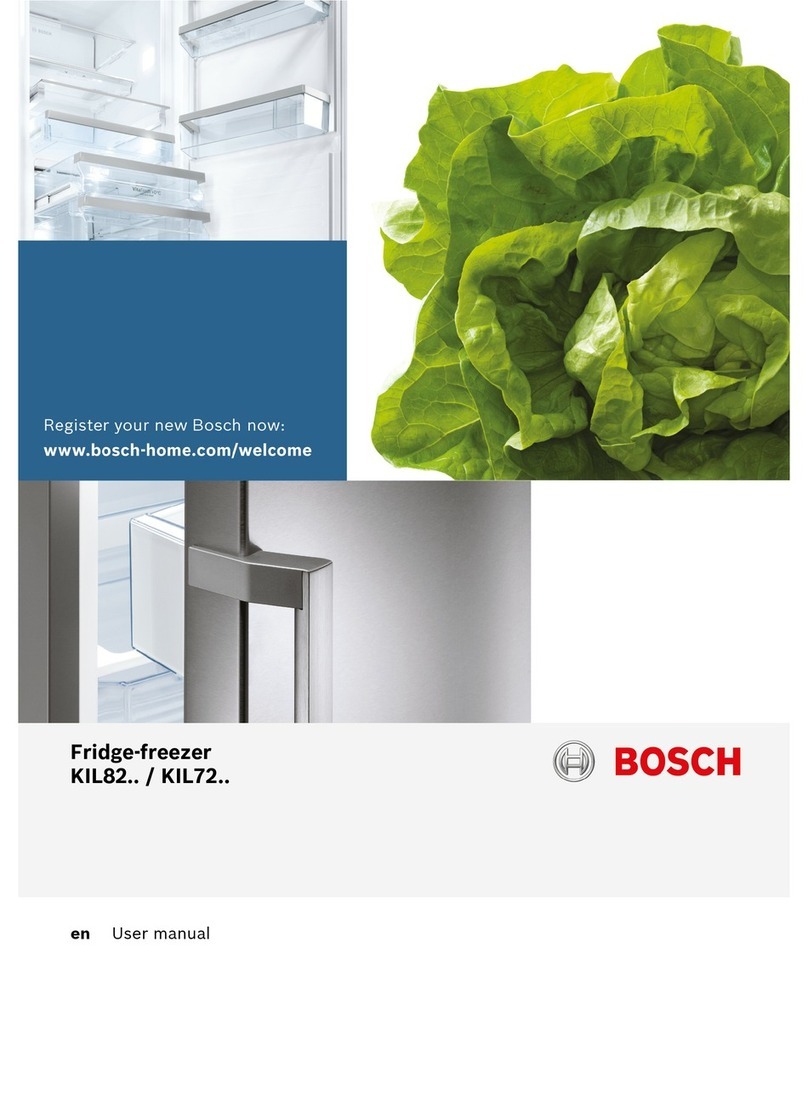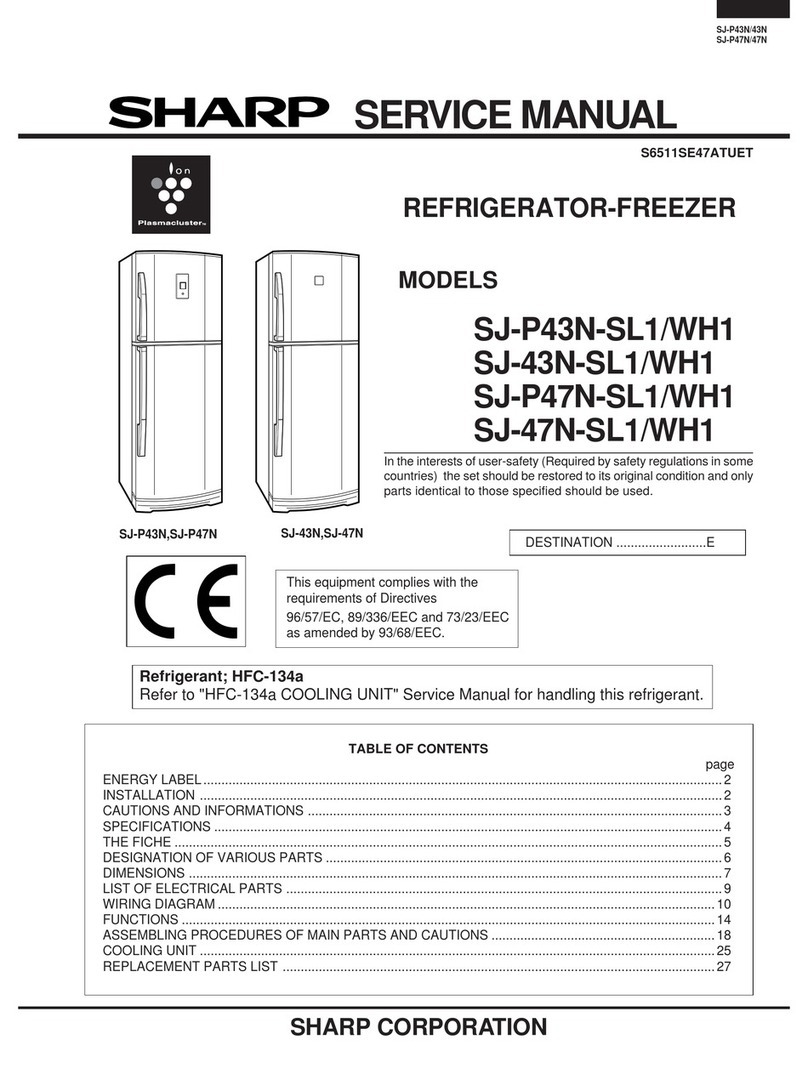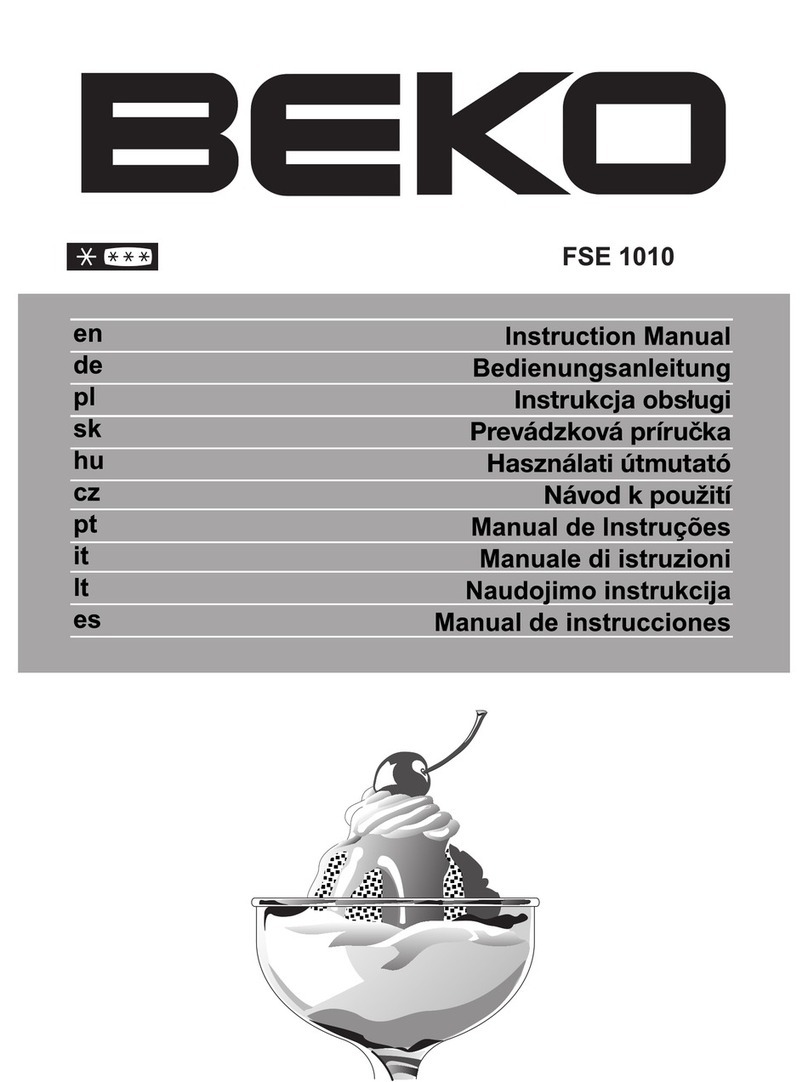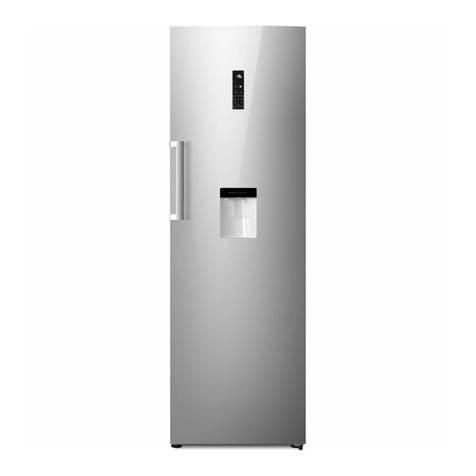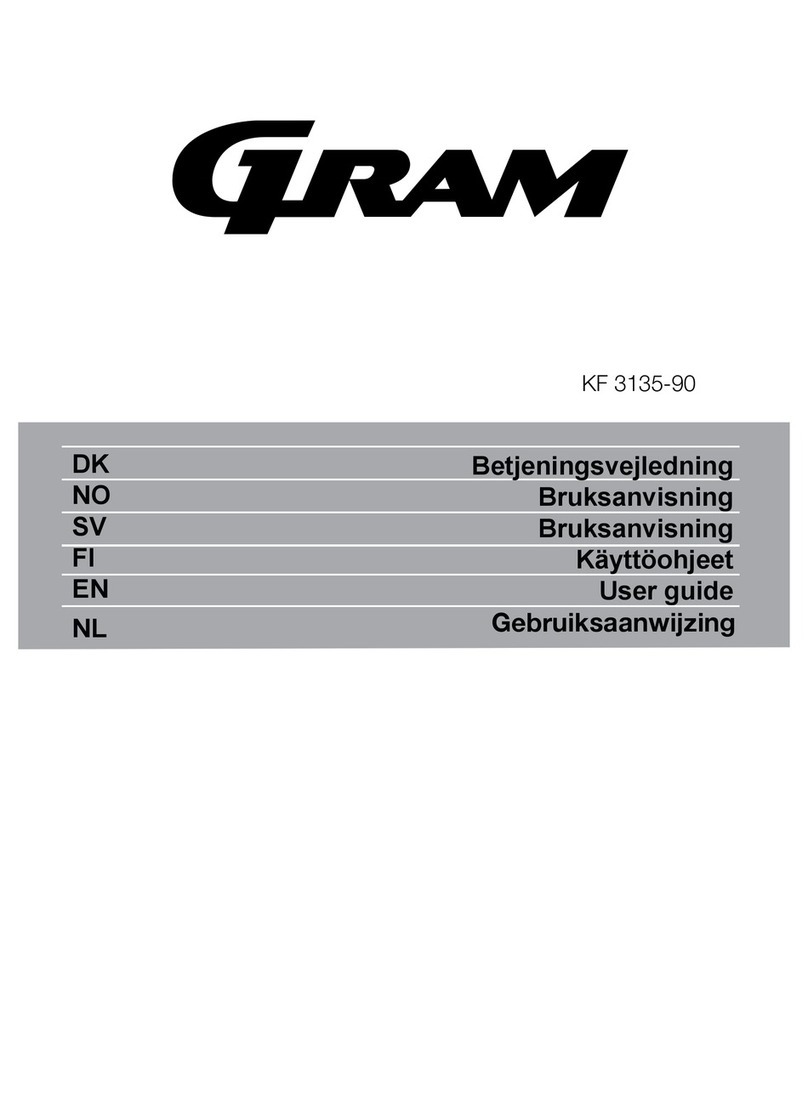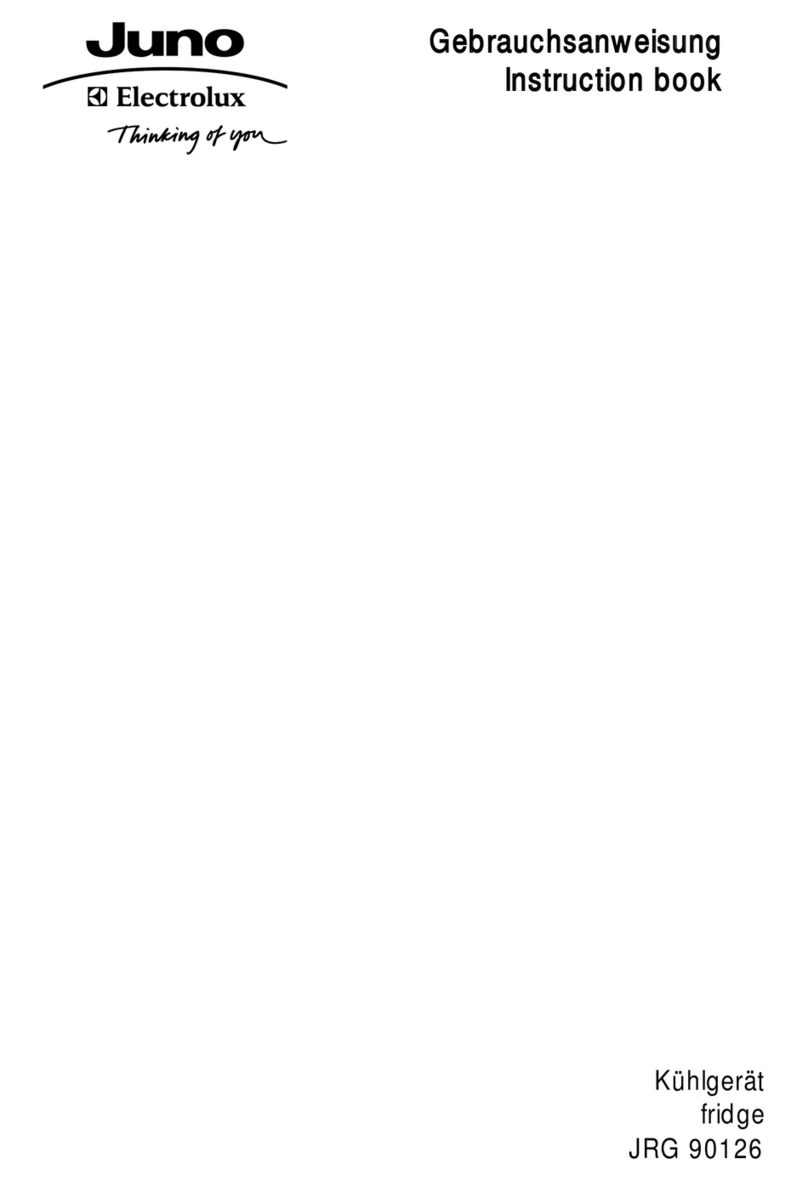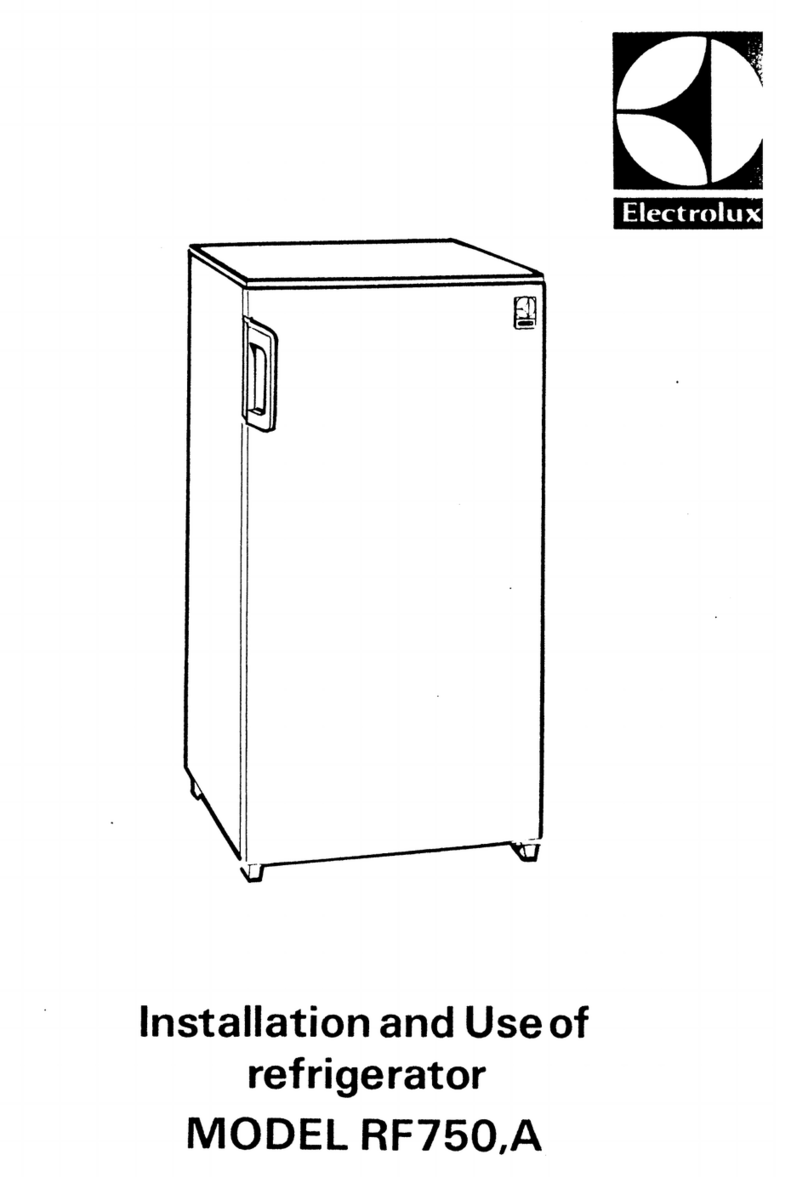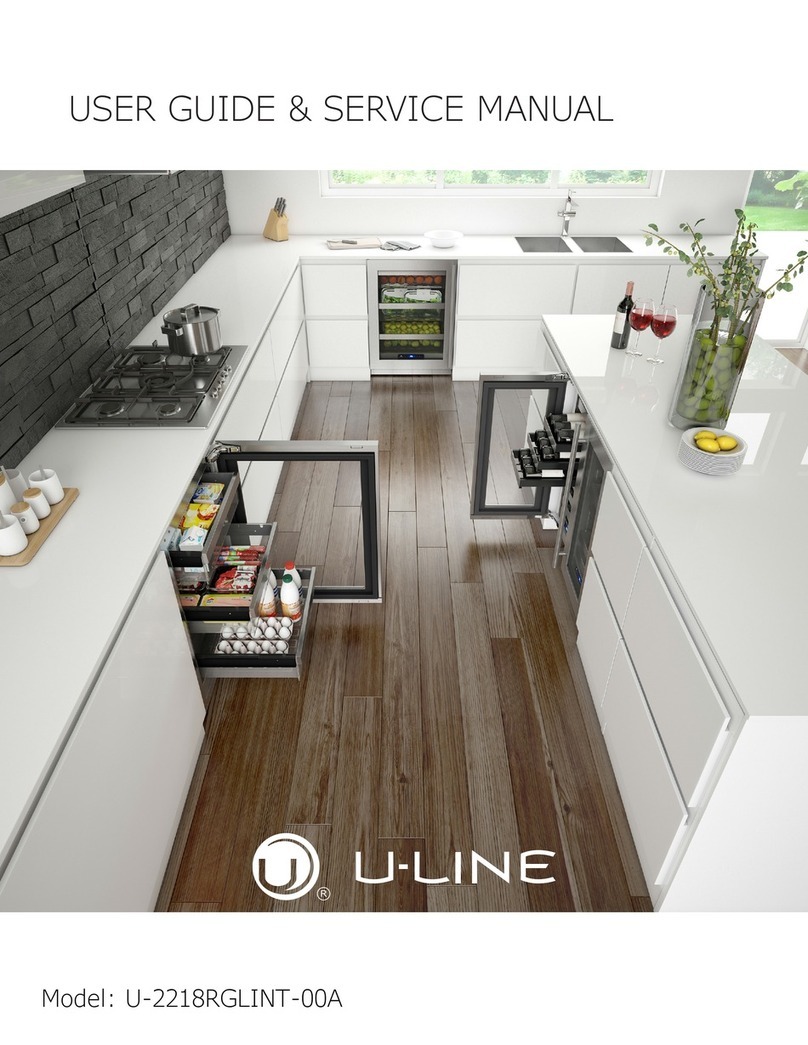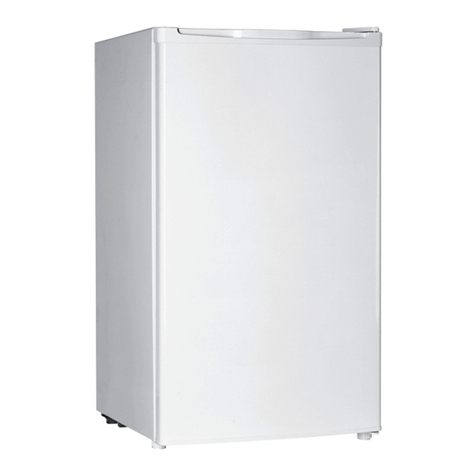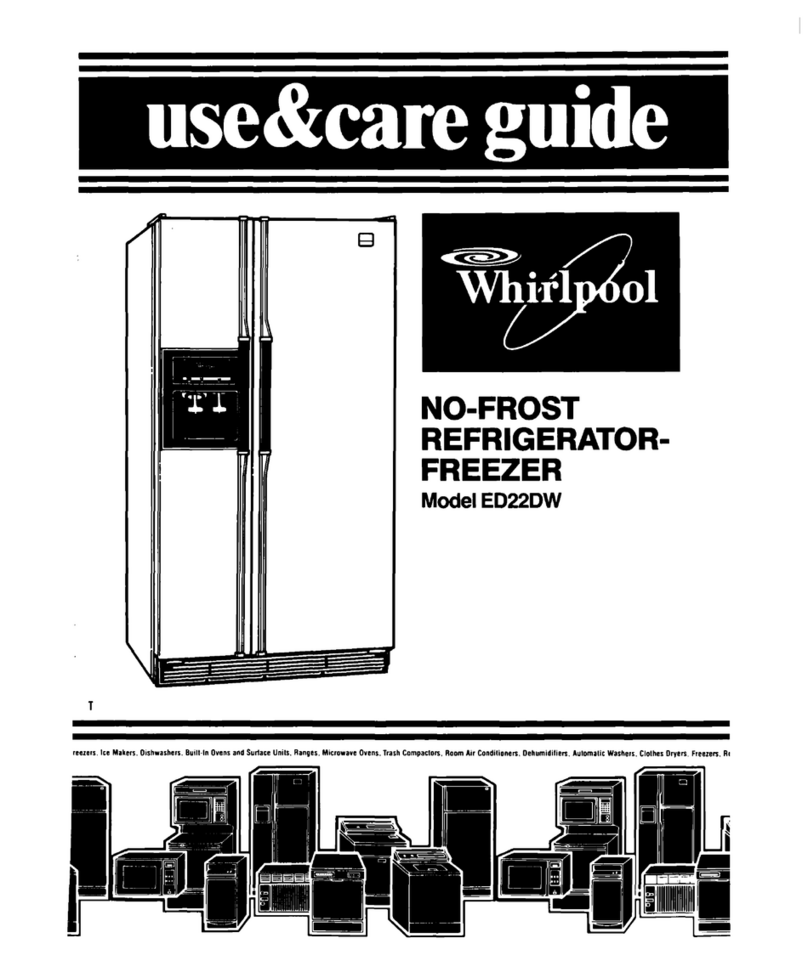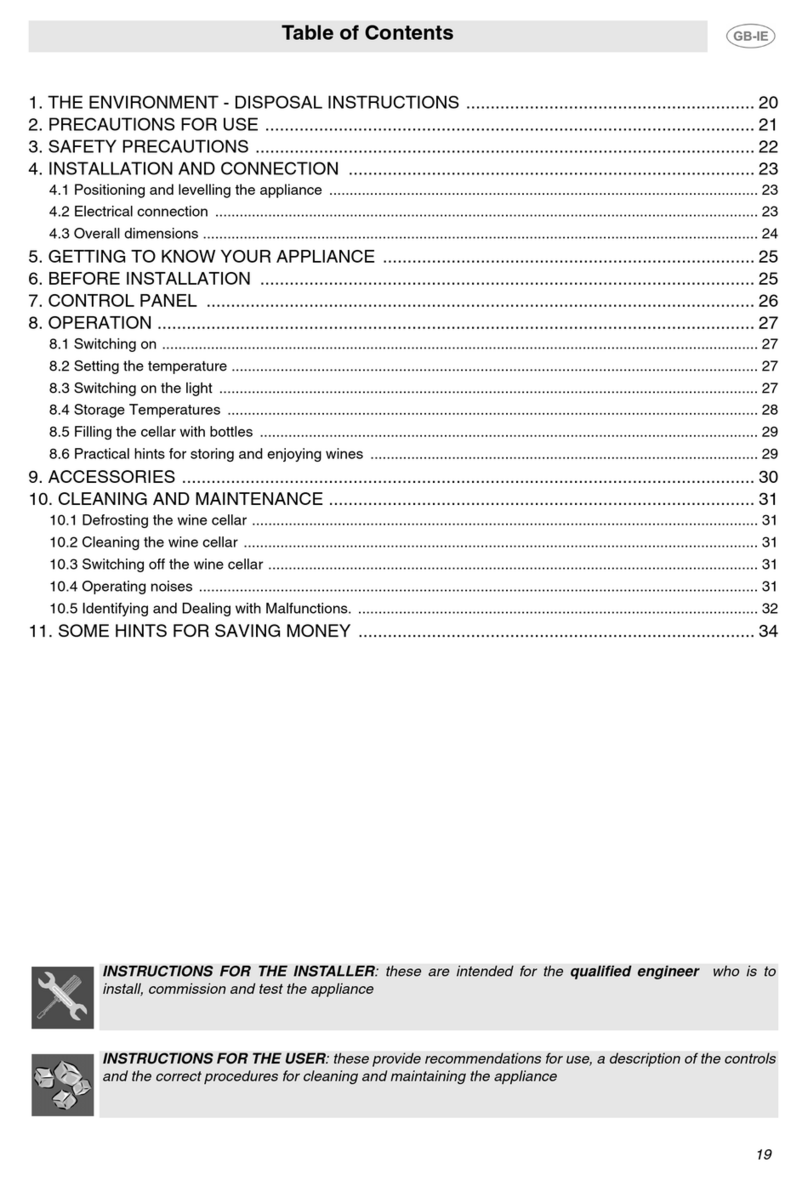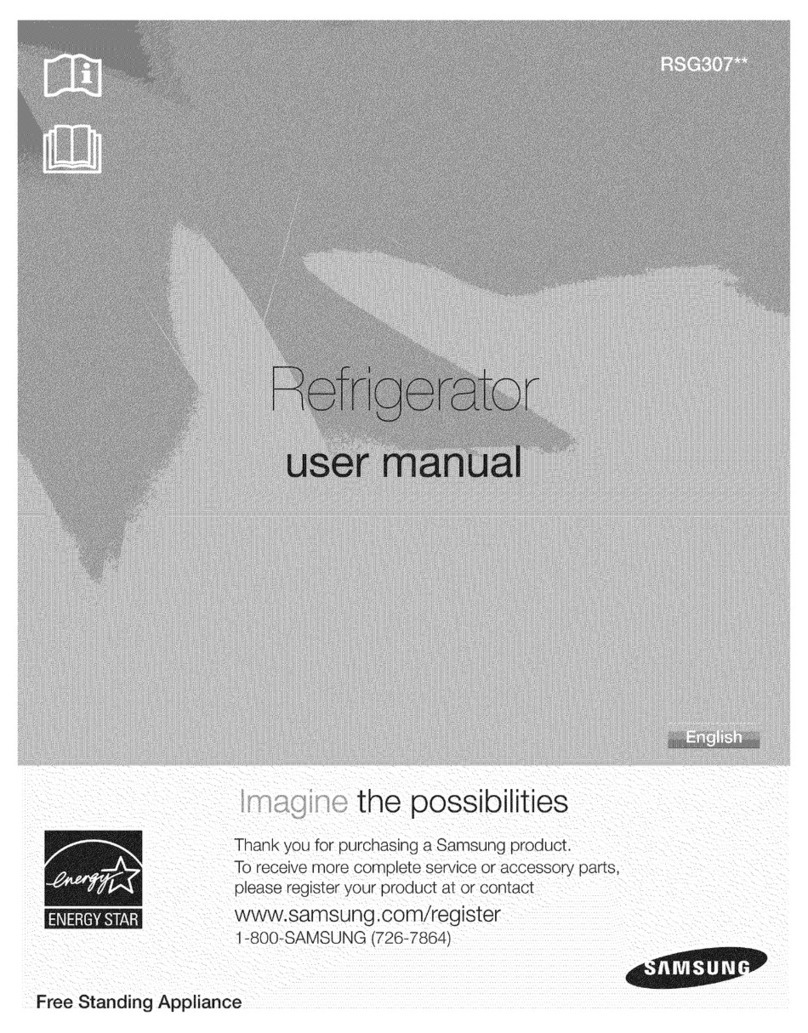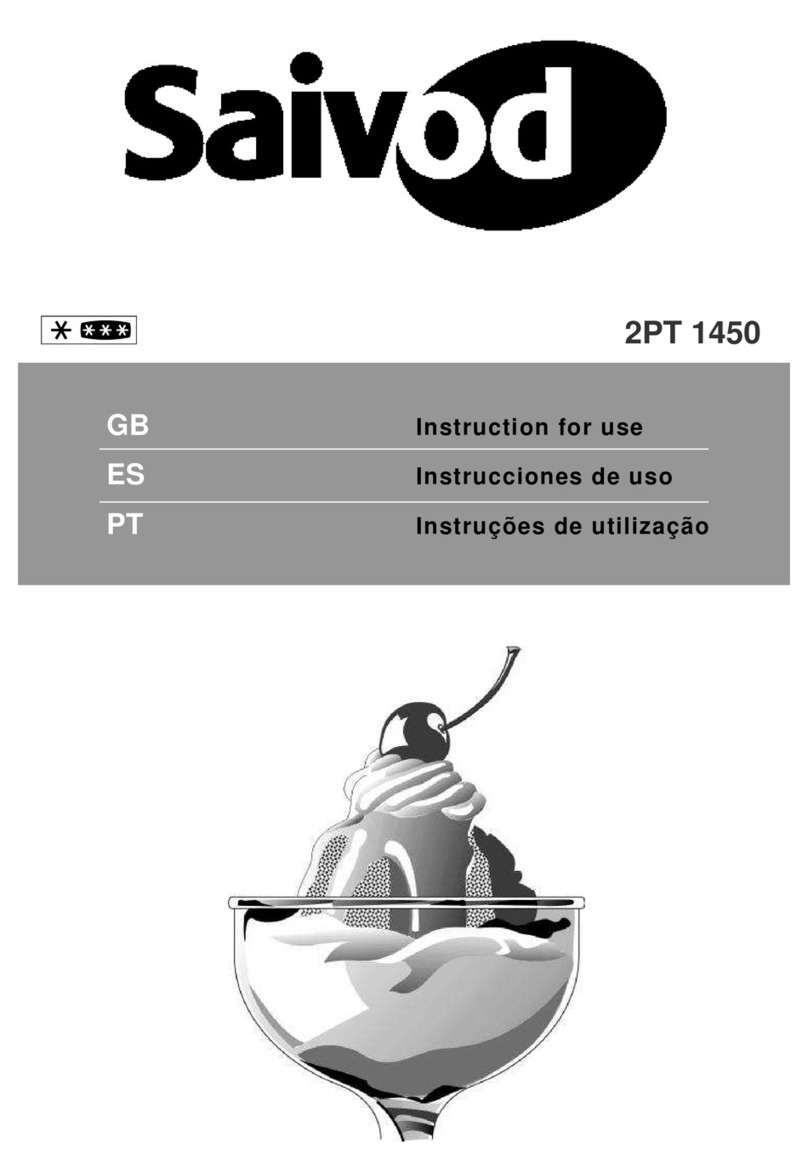Flavel FC7030FAPC User manual

FC7030FAPC
Frost Free Combi
Fridge / Freezer

Please read this manual first!
Dear Customer,
We hope that your product, which has been produced in modern factories and
checked under the most meticulous quality control procedures, will provide you
with years of good service.
For this, we recommend you to carefully read the entire manual of your product
before using it and keep it at hand for future reference.
This manual
• Will help you use your appliance quickly and safely.
• Read the manual before installing and operating your product.
• Follow the instructions, especially those for safety.
• Keep the manual in an easily accessible place as you may need it later.
• Besides, read also the other documents provided with your product.
Please note that this manual may be valid for other models as well.
Symbols and their descriptions
This instruction manual contains the following symbols:
CImportant information or useful usage tips.
AWarning against dangerous conditions for life and property.
BWarning against electric voltage.

EN
3
CONTENTS
1 Your refrigerator 4
2 Warnings 5
Electrical Requirements .....................6
Warning! This Appliance Must Be
Earthed .............................................6
Energy Saving Tips............................7
3 8
Transportation Instructions 8
Installation Instructions ......................8
Replacing The Interior Light Bulb ....10
Reversing the doors ........................12
4 Before operating 13
Final Check .....................................13
5 Using your refrigerator 14
Temperature Control And
Adjustment......................................14
Suggested Arrangement Of Food In
The Fridge/Freezer ..........................15
Storing Frozen Food........................16
Freezing Fresh Food ........................16
Making Ice Cubes............................16
Defrosting........................................17
6 Maintenance and cleaning 18
7 Do’s and Don’ts 19

EN
4
1Your refrigerator
CFigures that take place in this instruction manual are schematic and may not
correspond exactly with your product. If the subject parts are not included in the
product you have purchased, then it is valid for other models.
1
2
1
3
4
4
4
5
6
7
8
8
9
10
11
1
1.Fridge compartment door shelves
2.Egg holders
3.Bottle Shelf
4.Deep-freeze compartment
5.Freezer Fan
6.Crisper
7.Defrost water collection channel - Drain
tube
8.Adjustable body shelves
9.Wine rack
10.Interior Light
11.Thermostat knob
Congratulations on your choice of a FLAVEL quality Appliance which has been
designed to give you service for many years.

EN
5
2Warnings
•DO NOT connect your appliance to
the electricity supply until all packing
and transit protectors have been
removed.
• Leave to stand for at least 4
hours before switching on to allow
compressor oil to settle if transported
horizontally.
• If you are discarding an old
refrigerator with a lock or latch fitted to
the door, disable the lock/latch, ensure
that it is left in a safe condition to prevent
the entrapment of young children.
• This fridge/freezer must only be
used for its intended purpose i.e the
storing and freezing of edible foodstuff.
• Do not dispose of the appliance
on a fire. At FLAVEL, the care and
protection of our environment is an
ongoing commitment. This appliance
which is among the latest range
introduced is particularly environment
friendly. Your appliance contains non
CFC / HFC natural substances in the
cooling system (Called R600a) and in
the insulation (Called cyclopentane)
which are potentially flammable if
exposed to fire. Therefore, take care not
to damage, the cooling circuit / pipes
of the appliance in transportation and in
use. In case of damage do not expose
the appliance to fire or potential ignition
source and immediately ventilate the
room where the appliance is situated.
• We suggest you contact your local
authority for disposal information and
facilities available.
• To obtain the best possible
performance and trouble free operation
from your appliance it is very important
to carefully read these instructions.
• On delivery, check to make sure that
the product is not damaged and that all
the parts and accessories are in perfect
condition.
• Ensure that the plug remains readily
accessible. Do not use multiple adapter
bar or extension cable.
• Failure to observe these instructions
may invalidate your right to free service
during the guarantee period.
• Keep ventilation openings, in the
appliance enclosure or in the built-in
structure, clear of obstruction.
• Do not use mechanical devices
or other means to accelerate the
defrosting process, other than those
recommended by the manufacturer.
• Do not damage the refrigerant
circuit.
• Do not use electrical appliances
inside the food storage compartments
of the appliance, unless they are
of the type recommended by the
manufacturer.
• We suggest you keep these
instructions in a safe place for easy
reference.
• This appliance is not intended for
use by persons (including children) with
reduced physical, sensory or mental
capabilities, or lack of experience
and knowledge, unless they have
been given supervision or instruction
concerning use of the appliance by a
person responsible for their safety.
• Children should be supervised to
ensure that they do not play with the
appliance.

EN
6
FITTED WITH
BS 1362 13A FUSE ALWAYS
FIT BS 1362 REPLACEMENT
CARTRIDGE FUSE
GREEN &
YELLOW
OR
GREEN
N
BLUE
OR
BLACK
L
BROWN
OR
RED
22mm.
6mm.
6mm.
6mm. 32mm.
12mm.
FUSE
CORD GRIP
Electrical Requirements
Before you insert the plug into the
wall socket make sure that the voltage
and the frequency shown on the rating
plate inside the appliance corresponds
to yourelectricity supply.
Rating label is on the left hand side of
fridge inner liner.
We recommend that this appliance be
connected to the mains supply via a
suitable switched and fused socket.
The appliance must be positioned so
that the plug is accessible.
Warning! This Appliance
Must Be Earthed
If the fitted moulded plug is not suitable
for your socket, then the plug should be
cut off and an appropriate plug fitted.
Destroy the old plug which is cut off as
a plug with bared cord could cause a
shock hazard if inserted into a socket
elsewhere in the house.
The moulded plug on this appliance
incorporates a 13 A fuse. Should the
fuse need to be replaced an ASTABEAB
approved BS 1362 fuse of the same
rating must be used. Do not forget
to refit the fuse cover. In the event of
losing the fuse cover the plug must not
be used until a replacement fuse cover
has been fitted.
Colour of the replacement fuse cover
must be the same colour as that visible
on the pin face of the plug. Fuse covers
are available from any good electrical
store.
Important! Fitting A Different Plug
As the colours of the wires in the
mains lead of this appliance may not
correspond with the coloured markings
identifying the terminals in your plug
proceed as follows: (See diagram).
1. Connect the green-yellow or green
(Earth) wire to the terminal in the plug
marked ‘E’ or with the symbol or
coloured green and yellow or green.
2. Connect the blue (Neutral) wire to
the terminal in the plug marked ‘N’ or
coloured black.
3. Connect the brown (Live) wire to
the terminal in the plug marked ‘L’ or
coloured red.
Should the mains lead of the appliance
become damaged or should it need
replacing at any time, it must be
replaced by a special purpose made
mains lead which can only be obtained
from a FLAVEL Authorised Service
Agent.
WARNING: When positioning the
appliance ensure the supply cord is not
trapped or damaged.
WARNING: Do not locate extension
sockets or charging transformers/
power supplies or Lithium-Iron battery
operated products adjacent to the
compressor as they could overheat.

EN
7
With alternative plugs a 13 A fuse must
be fitted either in the plug or adaptor or
in the main fuse box. If in doubt contact
a qualified electrician.
Energy Saving Tips
1- Ensure your appliance is installed in
a well ventilated area.
2- Ensure the time between buying
chilled/frozen food and placing them
in your appliance is kept at minimum,
particularly in summer. We recommend
you use a cool bag or a special carrier
bag to carry frozen food.
3- Do not leave the door (s) of your
appliance open longer than necessary
and ensure they are closed properly
after each opening.
4- Defrost frozen food in the fridge
compartment, so that frozen food acts
as an ice pack to assist cooling in the
fridge.

EN
8
Transportation Instructions
1. The appliance should be transported
only in a vertical upright position. The
packing as supplied must be intact
during transportation.
2. If during the course of transport the
appliance has to be transported
horizontally, it must only be laid on its
right hand side when standing in the
front of the appliance. After bringing
it to upright position,it must not be
operated for at least 4 hours to allow
the system to settle.
3. Failure to comply with the above
instructions could result in damage
occuring to the appliance. The
manufacturer will not be held
responsible if these instructions are
disregarded.
4. The appliance must be protected
against rain, moisture and other
atmospheric influences.
5. When positioning your appliance take
care not to damage your flooring,
pipes, wall coverings etc. Do not
move the appliance by pulling by the
door or handle.
6. Empty any water in the drain
tray before moving. See section
‘Defrosting’ and ‘Care & cleaning’ for
further information.
7. Make sure that the defrost water
pipe at the back of the product is
fixed to the plastic evaporating pan
on the top of the compressor, to
avoid defrost water spillage on the
floor.
Important :
Care must be taken while cleaning
/ carrying the appliance to avoid
touching the bottom of the condenser
metal wires at the back of the appliance
as you might injure your fingers and
hands.
Do not attempt to sit or stand on top
of your appliance as it is not designed
for such use. You could injure yourself
or damage the appliance.
“IMPORTANT: Make sure that mains
cable is not caught under the appliance
during and after carrying / moving the
appliance, to avoid the mains cable
becoming cut or damaged.”
Do not allow children to play with the
appliance or tamper with the controls.
FLAVEL declines to accept any liability
should the instructions not be followed.
Installation Instructions
1. The space in the room where the
appliance is installed must not be
smaller than 10 cubic metres.
2. This appliance is designed to operate
at temperatures specified in the table
below is equipped with Advanced
Electronic Temperature Control
System [AETCS] which ensures that
at the advised setting [4 - four on the
knob] the frozen food in the freezer
will not defrost even if the ambient
temperature falls as low as -15 °C.
When first installed the product
MUST NOT be placed in low ambient
temperatures because the freezer will
not reduce to it’s standard operating
temperature. Once it has reached
its steady operating state it can be
3

EN
9
re-located. So you may then install
your appliance in a garage or an
unheated room without having to
worry about frozen food in the freezer
being spoilt. However at low ambient
temperatures mentioned above,
fridge contents are likely to freeze,
so check and consume food in the
fridge accordingly. When the ambient
temperature returns to normal, you
may change the knob setting to suit
your needs.
CIf the ambient temperature is below
0°C, the food in the fridge compartment
will freeze.So, we recommend you don’t
use the fridge compartment in such low
ambient conditions. You can continue
using the freezer compartment as
usual.
3. Do not place the appliance near
cookers, radiators or in direct sunlight
as this will cause your appliance to
work harder. If installed next to a
source of heat or freezer, maintain the
following minimum side clearances:
From Cookers 50 mm (2”)
From Radiators 300 mm (12”)
From Freezers 25 mm (1”)
4. Make sure that sufficient room is
provided around the appliance to
ensure free air circulation. Fit the two
plastic wall spacers supplied with the
appliance to the condenser on the
back of the appliance by rotating 1/4
turn. (See Diagram).
5. The fridge/freezer should be located
on a smooth surface. The two front
feet can be adjusted as required. To
ensure that your appliance is standing
upright adjust the two front feet by
turning clockwise or anti-clockwise,
until the product is in firm contact with
the floor. Correct adjustment of feet
avoids excessive vibration and noise.
6. Refer to cleaning and care section to
prepare your appliance for use.
7. A special receptacle is supplied to
store the mains plug during transit.
The receptacle is fixed at the back
of the cabinet, on the side of the
compressor. (See diagram) Gently
remove the plug from the receptacle.
Never pull the mains cord, you may
damage the appliance. In the case
of transportation, ensure you locate
the plug in the receptacle provided to
avoid transit damage.


EN
11
REVERSING THE DOORS
Top Door
1.Unscrew top hinge (4).
2.Carefully remove the top door.
3.Unscrew lower hinge (6)
4.Remove plastic plugs (10 &11).
5.Refit top hinge (4) as lower hinge
(14) on the left hand side.
6.Replace top door
7.Refit lower hinge (6) as top hinge
(16) on the left hand side.
Lower door
1.Unscrew top hinge (7)
2.Carefully remove the lower door.
3.Unscrew lower hinge (9).
4.Remove plastic plugs (12 &13).
5.Refit hinge (7) as lower hinge (19) on
the left hand side.
6.Replace lower door
7.Refit lower hinge (9) as top hinge
(21) on the left hand side.
Refit plastic plugs (10, 11, 12& 13)
into the screw holes on the right hand
side (17, 18, 22 & 23).
Screw the plastic fixing piece (1) to the
top of the appliance.
Stick the decorative sealing strip (3) to
the right hand side of the appliance.

EN
12
1
23
4
7
6
9
5
8
10
11
12
13
14
16
17
18
22
23
15
20
21
19
Reversing the doors
Proceed in numerical order .

EN
13
4Before operating
Final Check
Before you start using the fridge/
freezer check that:
1. The feet have been adjusted for
perfect levelling.
2. The interior is dry and air can
circulate freely at the rear of the cabinet.
3. Clean the interior as recommended
under “CLEANING AND CARE.”
4. Insert the plug into the wall socket
and switch on the electricity supply.
• When the door is open the fridge
interior light will come on.
5. You will hear a noise as the
compressor starts up. The liquid and
gases sealed within the refrigeration
system may also give rise to noise,
whether the compressor is running or
not which is quite normal.
“Due to operation of the fan inside
the frost free freezer compartment,
overall noise level is slightly higher
in comparison to non-frost free
appliances. This is quite normal and is
not a fault.”
6. Set the thermostat knob half way
between 1 and 5.
7. Front edges of the cabinet may
feel warm. This is normal. These areas
are designed to be warm to avoid
condensation.
8. “Do not load the appliance
immediately it is switched on. Wait until
the correct storage temperature
has been reached. We recommend
that you check the temperature
with an accurate thermometer (see;
Temperature Control and Adjustment)”

EN
14
5Using your refrigerator
Temperature Control And
Adjustment
Operating temperatures are controlled
by the thermostat knob (see diagram)
located on the ceiling of fridge
compartment. Settings may be made
from 1 to 5, 5 being the coldest position.
When the appliance is switched on
for the first time, the thermostat should
be adjusted so that after 24 hours, the
average fridge temperature is no higher
than +5°C (+41°F). We recommend you
set the thermostat half way between
the 1 and 5 setting and monitor to
obtain the desired temperature i. e.
towards 5 you will obtain a colder fridge
temperature and vice versa. Some
sections of the fridge may be cooler or
warmer ( such as the salad crisper and
the top part of the cabinet ) which is
quite normal.
The normal storage temperature of the
freezer should be -18°C (0°F). Lower
temperatures may be obtained by
adjusting thermostat knob towards 5
position.
We recommend that you check
the temperature with an accurate
thermometer to ensure that the storage
compartments are kept to the desired
temperature.
Remember you must take your reading
very quickly since the thermometer
temperature will rise very rapidly after
you remove it from the freezer.
Please remember each time the door
is opened cold air escapes and the
internal temperature rises. Therefore
never leave the door open and ensure
it is closed immediately after food is put
in or removed.
In case of a temporary ice build up
in the fridge compartment, reduce the
thermostat setting to 1, monitoring
at the same time that the fridge
temperature is maximum +5 degrees
C [41 degrees F]. Once the ice build
up disappears and the appliance
starts auto defrosting again as normal,
then you may increase the thermostat
setting, if required.

EN
15
Suggested Arrangement Of
Food In The Fridge/Freezer
Arrangement Examples (See diagram)
9
7
8
7
7
5
6
6
3
4
1
1
1
2
1. Baked, chilled cooked food, dairy
products, cans.
2. Meat, sausages, cold cuts.
3. Fruit, vegetables, salads.
4. Making, storing ice cubes.
5. Frozen food.
6. Frozen food and freezing of fresh
food.
7. Butter, cheese.
8. Small bottles, cans, tubes.
9. Eggs.
10. Tall, large bottles,
beverages.
The following guidelines and
recommendations are suggested to
obtain the best results and storage
hygiene.
1. The fridge compartment is for the
short term storage of fresh food and
drinks.
2. The freezer compartment is
rated and suitable for the freezing
and storage of pre frozen food. The
recommendation for storage
as stated on the food packaging should
be observed at all times.
3. Cooked dishes must be stored in
airtight covered containers.
4. Fresh wrapped produce can be
placed on the shelf. Fresh fruit and
vegetables should be cleaned and
stored in the crisper bins.
5. Bottles can be placed in the door
section.
6. To store raw meat, wrap in polythene
bags and place on the lowest shelf. Do
not allow to come into contact with
cooked food to avoid contamination.
For safety, only store raw meat for two
to three days.
7. Keep the food packed wrapped or
covered. Allow hot food and beverages
to cool before placing them in the fridge.
Do not store explosive substances.
High proof alcohol must be stored
upright in sealed containers. Left over
canned food should not be stored in
the can.
8. Fizzy drinks should not be frozen
and products such as flavoured water
ices should not be consumed too cold.
9. Some fruit and vegetables suffer
damage if kept at temperatures near
0°C. Therefore wrap pineapples,
melons, cucumbers, tomatoes and
similar produce in polythene bags.
10. Place chilled cooked food and
similar food near the rear of the fridge
inner liner where the cold wall is located.

EN
16
11. Shelves, racks, crisper bins,
drawers, flaps, bottle grippers are all
removable.
12. Do not leave frozen food at room
temperature to thaw; the best way to
defrost food is to put it in the fridge
to thaw slowly. Make sure you avoid
defrosting food or food juices drip onto
other food.
13. For hygiene reasons, always wrap
food using a suitable packaging material
before storing in your appliance to avoid
contact with the appliance surface.
Storing Frozen Food
Prepacked commercially frozen food
should be stored in accordance with
the
frozen food manufacturer’s instructions
for a frozen food storage
compartment.
To ensure that the high quality achieved
by the frozen food manufacturer and
the
food retailer is maintained, the
following should be remembered:
1. Put packets in the freezer as quickly
as possible after purchase.
2. Ensure that contents are labelled
and dated.
3. Do not exceed “Use By”, “Best
Before” dates on the packaging.
If there is a power failure do not open
the door. Frozen food should not be
affected if the failure lasts for less than
13 hrs. If the failure is longer, then the
food should be checked and either
eaten immediately or cooked and then
re-frozen.
Freezing Fresh Food
Please observe the following
instructions to obtain the best results.
Do not freeze too large a quantity at
any one time. The quality of the food
is best preserved when it is frozen
right through to the core as quickly as
possible.
Placing warm food into the freezer
compartment causes the refrigeration
compressor to operate continuously
until the food is frozen solid. This can
temporarily lead to excessive cooling of
the refrigeration compartment.
When freezing fresh food turn the
setting knob towards. Max small
quantities of food up to 1/2 kg. (1 lb)
can be frozen without having to rotate
the temperature control knob.
You may place fresh food to be frozen
in any part of the freezer.
Take special care not to mix already
frozen food and fresh food.
Making Ice Cubes
Fill the ice - cube tray 3/4 full with
water and place it in the Ice Bank.
Loosen frozen trays with the handle of a
spoon, never use sharp edged objects
such as knives, forks. Store ice-cubes
in the Ice Bank.
Note: If freshly made ice cubes are
not consumed for several weeks and
stored in Ice Bank, they will slowly
reduce in size and eventually disappear
completely.

EN
17
Defrosting
A) Fridge Compartment
The fridge compartment defrosts
automatically. The defrosting water
runs to the drain tube via a collection
container at the back of the appliance
(1).(see diagram) During defrosting
water droplets may form at the back of
the fridge compartment
where concealed evaporator is
located.Some droplets may remain on
the liner and refreeze when defrosting is
completed. Do not use pointed or sharp
edged objects such as knives, forks to
remove the droplets which have frozen.
If at any time the defrost water does
not drain from the collection channel,
check to ensure that no food particles
have blocked the drain tube. The drain
tube can be cleared by pushing the
special plastic plunger provided down
the drain tube (2). If the frost layer
reaches about 1/4”(7 mm), reduce
the setting (i.e. from 4 to 1) to restart
automatic defrosting.
B) Freezer Compartment
The freezer compartment defrosts
automatically.
Warnings!
The fan inside the freezer compartment
circulates cold air. Never insert
any object through the guard. Do not
allow children to play with
the freezer fan.
Never store products that contain
inflammable propellant gas
(eg dispensers, spray cans etc.) or
explosive substances.
Don’t cover the shelves with any
protective materials, which may
obstruct air circulation.
Do not allow children to play with the
appliance or tamper with the controls.
Do not obstruct the freezer fan
guard to ensure that you obtain the
best possible performance from your
appliance.

EN
18
6Maintenance and cleaning
** We recommend that you switch off
the appliance at the socket outlet and
pull out the mains plug before cleaning.
** Never use any sharp abrasive
instrument, soap, household cleaner,
detergent and wax polish for cleaning.
** Use luke warm water to clean the
cabinet of the appliance and wipe it dry.
** Use a damp cloth wrung out in a
solution of one teaspoon of bicarbonate
of soda to one pint of water to clean the
interior and wipe it dry.
** Make sure that no water enters the
lamp housing.
** If the appliance is not going to be
used for a long period of time switch it
off, remove all food, clean it and leave
the door ajar.
** Any dust that gathers on the
condenser, which is located at the back
of the appliance, should be removed
once a year with a vacuum cleaner.
** Check door seals regularly to
ensure they are clean and free from
food particles.
** Removal of door tray
• To remove door racks, remove
all the contents and then simply push
the door rack upwards from the base.
** To remove a freezer drawer, pull it as
far as possible, and then tilt it upwards,
and then pull it out completely.
** To remove the freezer flap door, first
open the door 3” and then gently pull it
off. Make sure that the flap is in place
before closing the freezer door.
** Make sure that the special plastic
container (drain tray) at the back of
the appliance which collects defrost
water is clean at all times. If you want
to remove the tray to clean it follow the
instructions below :
• Switch off at the socket outlet and
pull out the mains plug.
• Push the lug down with the tip
of a screw driver & pull out with a jerk
movement
• Clean the drain tray and wipe it
dry.
• Reassemble reversing the
sequence and operations.
** Avoid spillage of food particularly
small items like rice, peas, beans
through the fan guard as they may
cause the cooling system to block and
therefore operate less efficiently.

EN
19
7Do’s and Don’ts
Do- Clean your appliance regularly (See
“Cleaning and Care”)
Do- Keep raw meat and poultry below
cooked food and dairy products.
Do- Take off any unusable leaves on
vegetables and wipe off any soil.
Do- Leave lettuce, cabbage, parsley and
cauliflower on the stem.
Do- Wrap cheese firstly in greaseproof
paper and then in a polythene bag
excluding as much air as possible.
For best results take out of the fridge
compartment an hour before eating.
Do- Wrap raw meat and poultry loosely
in polythene or aluminium foil. This
prevents drying.
Do- Wrap fish and offal in polythene
bags.
Do- Wrap food which have a strong
odour or can dry out in polythene
bags, aluminium foil or place in an
airtight container.
Do- Wrap bread well to keep it fresh.
Do- Chill white wines, beer, lager and
mineral water before serving.
Do- Check contents of the freezer every
so often.
Do- Keep food for as short a time
as possible and adhere to “Best
Before”, “Use by” etc. dates.
Do- Store commercially frozen food in
accordance with the instructions
given on the packets that you buy.
Do- Always choose high quality fresh
food and be sure it is thoroughly
clean before you freeze it.
Do- Prepare fresh food for freezing
in small portions to ensure rapid
freezing.
Do- Wrap all food in aluminium foil or
freezer quality polythene bags and
make sure any air is excluded.
Do- Wrap frozen food when you buy it
and put it in to the freezer as soon
as possible.
Do- Defrost food in the fridge
compartment.
Do- Remove ice cream from the freezer
10-20 minutes before serving.
Don’t- Store bananas in your fridge
compartment.
Don’t- Store melon in your fridge. It can
be chilled for short periods as long
as it is wrapped to avoid it flavouring
other food.
Don’t- Store poisonous or any
dangerous substances in your
appliance. It has been designed for
the storage of edible foodstuffs only.
Don’t- Consume food which has been
stored for an excessive time in the
fridge.
Don’t- Store cooked and fresh food
together in the same container. They
should be packaged and stored
seperately.
Don’t- Let defrosting food or food juices
drip onto food.
Don’t- Leave the door open for long
periods as this will make the
appliance more costly to run and
cause excessive ice formation.
Don’t- Put hot food into the appliance.
Let it cool down first.
Don’t- Put liquid-filled bottles or sealed
cans containing carbonated liquids
into the freezer as they may burst.
Don’t- Exceed the maximum freezing
loads (6 kg in any 24 hours) when
freezing fresh food.
Don’t- Give children ice-cream and water
ices direct from the freezer. The low
temperature may cause ‘freezer
burns’ on lips.

EN
20
Don’t- Freeze fizzy drinks.
Don’t- Try to keep frozen food which has
thawed, it should be eaten within 24
hours or cooked and refrozen.
Don’t- Remove items from the freezer
with wet hands.
Don’t- Close the freezer door before
placing the compartment cover in its
place.
Don’t- Leave frozen food at room
temperature to thaw; the best way
to defrost food is to put it in the
fridge to thaw slowly. Make sure you
avoid defrosting food or food juices
drip onto other food.
Problem Solvıng
If the appliance does not operate
when switched on, check whether:
• The plug is inserted properly in the
socket and that the power supply is
on. (To check the power supply to the
socket, plug in another appliance)
• The fuse has blown/circuit breaker
has tripped/main distribution switch
has been turned off.
• The temperature control has been
set correctly and not to “0” (OFF)
• New plug is wired correctly if you
have changed the fitted moulded plug.
If the appliance is still not operating
after the above checks, please refer to
the section on “How To Obtain Service”.
Please ensure that above checks have
been made as a charge will be made if
no fault is found.
Table of contents
Other Flavel Refrigerator manuals

